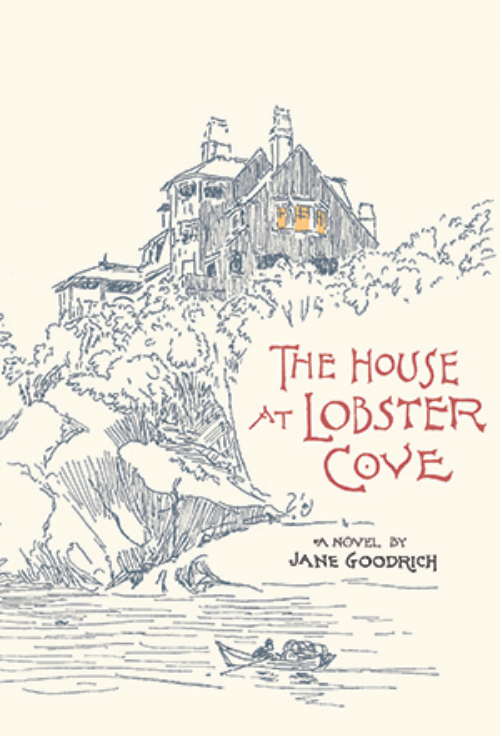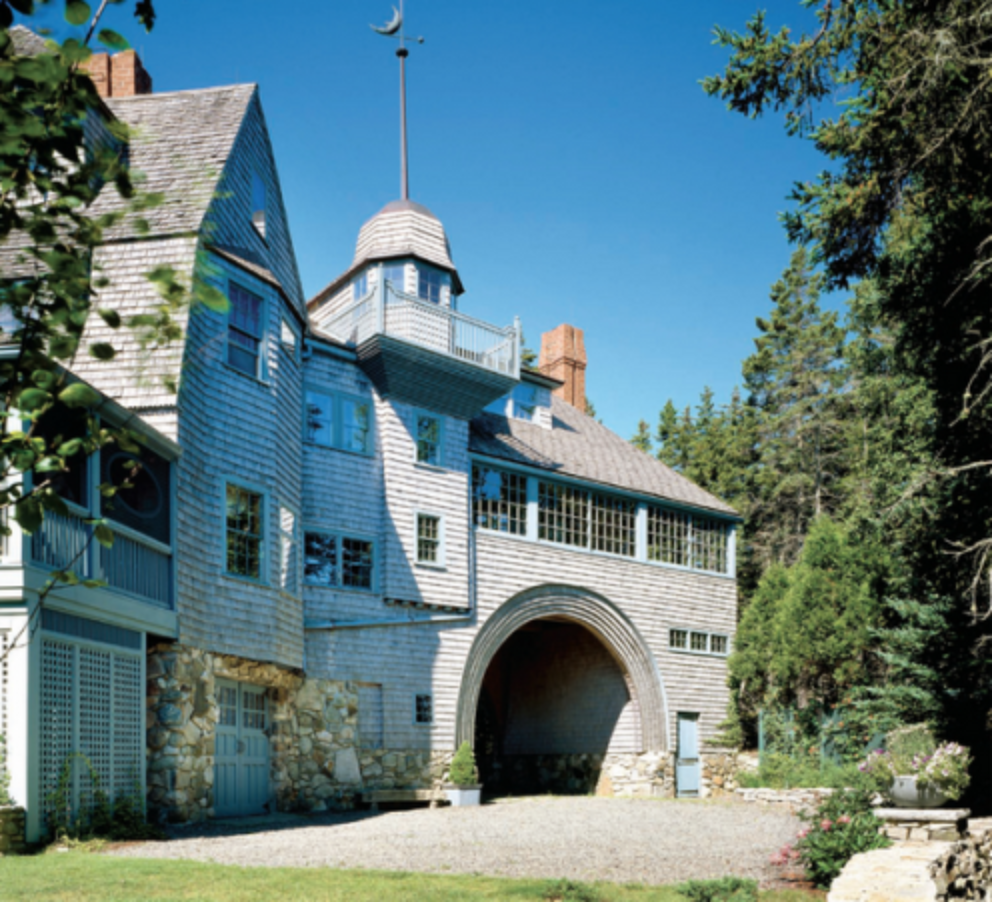The House at Lobster Cove: An Interview with Jane Goodrich
Selecting The House at Lobster Cove for Bas Bleu’s Book a Month 2018 program was an easy choice: Not only did our reviewer hail the novel as having “the grace, wit, language, and incisive character exploration of Edith Wharton’s work,” but Jane Goodrich’s debut novel features a beautiful letterpress-printed rendering of the titular house on its cover. Goodrich (co-owner of Saturn Press, a greeting card and stationery company whose holiday cards are Bas Bleu favorites) was a teenager when she fell in love with images of Kragsyde, a nineteenth-century Massachusetts shingle-style house, which was torn down in the 1920s. As an adult, she and her husband obtained the plans and spent fifteen years rebuilding the house on an island in Maine. Now she has written this marvelous novel about the unique life of philanthropist George Nixon Black, who commissioned the design and building of the original Kragsyde. Recently, Jane took a break during her long drive home to Maine to graciously answer our questions about rebuilding Kragsyde, the differences between writing novels and writing greeting cards, and the books that shaped her as a reader.
Bas Bleu: How did your love of a house develop into an interest in the man who built it?
Jane Goodrich: We re-built George Nixon Black’s house ourselves from the ground up, using the original nineteenth-century blueprints. In recreating these antique spaces it becomes impossible not to imagine how the original owners lived in them. (Click here to see interior photos of the “new” Kragsyde.) One wonders which window held their favorite view, which room was painted their favorite color. How the rooms were used also becomes a question. Which room held the history of a quarrel, a kiss, a death? Blueprints for spaces easily become blueprints for the scenes of daily life, and the more I learned about my characters from research, the more fascinating their lives became.
BB: What was the very first step in writing the novel? And how does the writing process compare to your creative work at Saturn Press?
JG: I created a notebook timeline of Black’s life in which I added his lifetime activities alongside current events of the day that might have affected or interested him. This was very effective for me in realizing his world. I then assembled my research, and decided upon my plot and devices. I broke this down into sections and began a second notebook. In this second notebook I would write scenes for the novel in the appropriate section. For instance when I thought of a nice phrase or description for a future scene I would note it in the section for that scene long before I wrote the entire scene. Once I arrived at that scene I would include some of these phrases in the manuscript or change or discard them. In writing the entire manuscript I began on page one and wrote in chronological order.
In comparing writing to the creative work I do at Saturn Press the processes seem alike only in that I am trying to convey a message. In designing or writing the text for a greeting card I am always conscious of my task of finding a clever, tender, or heartwarming way to speak for the customer who will eventually purchase the card. It is almost always the job of conveying a single thought. Writing a novel is much more complex, and involves many voices, and many sorts of descriptions. Novel writing also involves quite a bit of planning and construction. I find that writing is much more like building a house than designing a card.
BB: The novel taught us the horrifying true meaning of being “ridden out of town on a rail.” Did things you learned in your research about the prejudices and violence of the nineteenth century shock you?
JG: No. Every age has its horrors. In our hyper-informed times it seems the world changes every five minutes. In a longer view, I think the world does not change at all every 500 years. Human nature is fixed, and literature reminds me of that.
Jane Goodrich and her husband spent fifteen years rebuilding Kragsyde from original blueprints and photographs.
BB: What were the sources of your research? Did you access them via the internet? Libraries?
JG: My research took ten years and the sources were many. Everything from hotel registers in Egypt, to Civil War letters discovered in a descendant’s attic. Libraries were vital, but I did not make much use of the internet. Like real detective work, proper research requires shoe leather.
BB: You handled the homosexual love story with such delicacy. Were you deliberately avoiding a twenty-first century frankness on the subject?
JG: Yes, although I did not think of it that way. I avoided all twenty-first century speech, notions, fads, and sensibilities as best as I could in all aspects of the entire novel. I wrote the novel longhand with a fountain pen! I tried to write the love story as it would have felt to the men who lived it. We all think of our moments of love as beautiful, and I tried to write these scenes with beauty.
BB: We loved the way you neatly tied up the story with the finding of the missing collar stud as the house was being dismantled. Did you have that device in mind from the beginning?
JG: Yes, although in my planning notebook it was a button.
BB: Which book(s) from your childhood helped to shape the person you are today?
JG: My first book love was The Story About Ping by Marjorie Flack. I also loved The Peddler of Colored Threads by Winifred Shattuck and as an older child I will always remember White Bird by Clyde Robert Bulla. As a teen I read a lot of poetry (Neruda and Roethke were favorites) and I had a long love affair with The Great Gatsby by Fitzgerald and anything written by Tom Robbins. I suppose I must also mention The Stick Style and The Shingle Style by Vincent Scully. That one really altered my life!
BB: Aside from your own title(s), which books are you quick to recommend to other readers? Who are your favorite authors?
JG: Oh, there are so many! One of my favorites is now being offered in your catalog, All Passion Spent by Vita Sackville-West [also a 2018 Book a Month pick], but all the Bloomsbury group are wonderful. Bruno’s Dream by Iris Murdoch and Ancient Light by John Banville are both loved by me but I would read anything written by either author. Robert Penn Warren is responsible for my favorite first paragraph of any novel in his All the King’s Men as well as his stellar poetry. I was thrilled and awed you compared my prose to that of Edith Wharton as I enjoy all her books especially Ethan Frome, and her short story “Roman Fever” is in my opinion one of the best of all time. I have long admired Marguerite Duras’s The Lover and Vladimir Nabokov’s Lolita, especially contrasted with one another. I have just finished Stephan Benatar’s Wish Her Safe at Home which is the finest description of a descent into madness I have ever read. Then there is Henry James, Henry James, Henry James.
BB: What future projects can our readers look forward to seeing from you? Is there a second novel in the works?
JG: Unreliable narrators, Transcendentalist tough girls, glamorous spiritualists, deluded utopians, slick artificers, seances in darkened rooms, an employee of a leper colony, and a rooster named Pretty Boy. They are all lining up in another notebook. Stay tuned.
BB: Many thanks to Jane Goodrich for sharing her novel-writing (and house-building) experience with us!

